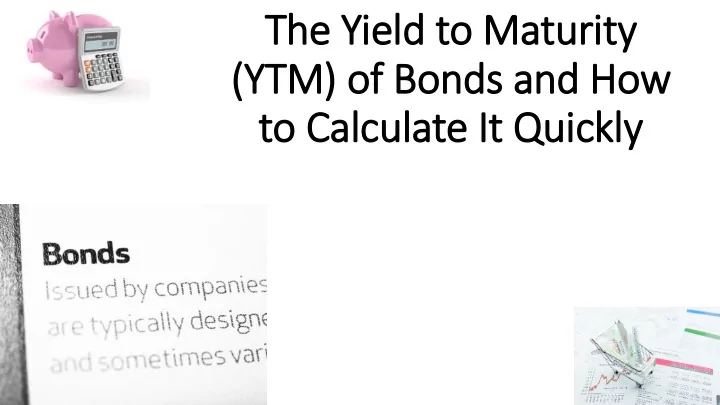

The Yield to M Maturity (YTM) of Bonds and How to C Calculate It Quickly
This Lesson: Very Important for DCM/LevFin We’re going to start looking at concepts relevant for Debt Capital Markets (DCM) and Leveraged Finance (LevFin) teams. This one is also relevant if you’re in Restructuring, or you’re interviewing for a credit fund or anything else debt- related.
This Lesson: Our Plan • Part 1: The Yield to Maturity (YTM) and What It Means • Part 2: How to Quickly Approximate YTM • Part 3: How to Extend the Formula to Yield to Call and Yield to Put • Part 4: How to Use This Approximation in Real Life
What Yie ield to Maturit ity (YTM) Means • Yield to Maturity: The internal rate of return (IRR) from buying the bond at its current market price and holding it to maturity • Assumption #1: You hold the bond until maturity • Assumption #2: The issuer pays all the coupon and principal payments in full on the scheduled dates • Assumption #3: You reinvest the coupons at the same rate • Intuition: What’s the average annual interest rate % + capital gain or loss % you earn from the bond?
How to Calculate the Yie ield to Maturit ity (YTM) • YIELD (Settlement Date, Maturity Date, Coupon Rate, Bond Price % Par Value Out of the Number 100, 100, Coupon Frequency) • =YIELD (“12/31/2014”, “12/31/2024”, 5%, 96.23, 100.00, 1) = 5.500% • =YIELD (“12/31/2017,” “6/30/2021”,6%,101.00,100.00,2) = 5.681% • IRR: This will only work for annual coupons – set the initial investment to the bond’s current market price and make the future cash flows equal the interest + principal payments
How to Quickly Approximate the YTM • Approximate YTM = Annual Interest + (Par Value – Bond Price) / # Years to Maturity (Par Value + Bond Price) / 2 • Intuition: Each year, you earn interest PLUS a gain on the bond price if it’s purchased at a discount (or a loss if it’s purchased at a premium) • And you earn that amount on the “average” between the initial bond price and the amount you get back upon maturity
How to Quickly Approximate the YTM • Example: 10-year $1,000 bond with a price of $900, coupon of 5% • Annual Interest = 5% * $1,000 = $50 • Par Value – Bond Price = $1,000 – $900 = $100 • (Par Value + Bond Price) / 2 = ($1,000 + $900) / 2 = $950 • Approximate YTM = ($50 + $100 / 10) / $950 = $60 / $950 = ~6.3%
Lim imitatio ions of the Quick Approximation • Limitation #1: Doesn’t work as well when the bond trades at a big discount or premium to par value • Limitation #2: Misaligned settlement and maturity dates and semi-annual and quarterly coupons will distort this figure • Limitation #3: Won’t work as well with floating interest rates (rare for bonds, but it happens…)
Call ll and Put Optio ions on Bonds • Company: Interest rates have fallen, or its credit rating has improved, so it wants to refinance at a lower rate • Call Options: Allow companies to redeem (repay) the bond early, usually at a premium to par value • In Exchange: These bonds must offer higher yields to investors because the investors are assuming more risk • Early Redemption: Investors will have to find somewhere else to redeploy their capital, possibly at lower rates
Ext xtending the Formula to Yield to Call and Put • Approximate YTC or YTP = Annual Interest + (Redemption Price – Bond Price) / # Years to Maturity (Redemption Price + Bond Price) / 2 • Example: 10-year $1,000 bond with a price of $900, coupon of 5%, and a call date 3 years from now at a redemption price of 103 • Approximate YTC = ($50 + ($1,030 – $900) / 3) / (($1,030 + $900) / 2) • Approximate YTC = ($50 + $43) / $965 = $93 /$965 = Just under 10% • Approximate YTC = ~9.7%
How to Use This Approximation in Real l Lif ife • Example: You’re at a credit fund that targets a 10% IRR on investments in high-yield debt • Potential Investment: 4-year, 7.950% unsecured bond from JC Penney, currently trading at 91.75 (% of par value) • Seems like an easy “yes”: (~8% interest per year + ~8% discount / 4) / Average Price of 96% = Yield of Just Over 10% • PROBLEM: Will a distressed company be able to repay the bond principal upon maturity? What if its financial situation worsens?
How to Use This Approximation in Real l Lif ife • You estimate the following recovery percentages: • Scenario 1 Approximate YTM: (8% – 27% / 4) / 78.5% = 1.6% • Scenario 2 Approximate YTM: (8% – 45% / 4) / 69.5% = -4.7% • CONCLUSION: Probably a “No Invest” decision if these recovery percentages are true – even in the Upside Case, we’re far below 10%
Recap and Summary • Part 1: The Yield to Maturity (YTM) and What It Means • Part 2: How to Quickly Approximate YTM • Part 3: How to Extend the Formula to Yield to Call and Yield to Put • Part 4: How to Use This Approximation in Real Life
Recommend
More recommend